 |


Antebellum Louisiana:
Politics, Education, and Entertainment

Louisiana Politics

Cultural differences and individual personalities, rather than
party platforms and philosophies, defined political lines in antebellum
Louisiana. Conflict between Anglo and Latin residents and between
northern and southern sections of the state infused most political
issues. Overall, wealthy planters and their merchant allies dominated
state government during this time.

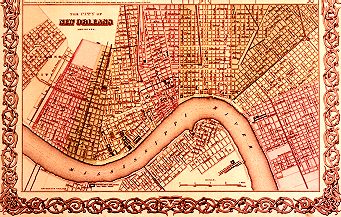
Map of Louisiana and the Three Municipalities
c. 1850
Sections reproduced from J. H. Colton and Company, The
City of New Orleans, 1855
This map shows the general political divisions between strongholds
of Democrats and Whigs in north and south Louisiana and between
Latins and Anglos in the New Orleans municipalities.

In general, the Florida parishes (formerly English and Spanish
possessions) and north Louisiana supported Anglo-American candidates
of the Democratic party. Many of the voters living in these areas
were Protestants of English or American descent. On the other
side of the political arena stood the wealthier planters and their
merchant allies from the sugar parishes of south Louisiana. Primarily
Catholics and native-born descendents of French and Spanish
colonists, south Louisiana voters supported issues championed
by the Whig party and its candidates.

 New Orleans reflected on a smaller scale the statewide conflict between Anglo and Latin factions. In 1836 the city was divided into three municipalities. Democrats drew support from an immigrant and Creole coalition of Catholics in the First and Third Municipalities. The Whig party and its successor, the American or so-called Know-Nothing party, attracted Protestant, native-born Anglo-Americans who mainly resided in the Second Municipality. New Orleans reflected on a smaller scale the statewide conflict between Anglo and Latin factions. In 1836 the city was divided into three municipalities. Democrats drew support from an immigrant and Creole coalition of Catholics in the First and Third Municipalities. The Whig party and its successor, the American or so-called Know-Nothing party, attracted Protestant, native-born Anglo-Americans who mainly resided in the Second Municipality.

 The Whig party dissolved in the 1850s, when slavery emerged as
a national issue and the party could no longer retain support
in both the North and South. Many former Whigs in Louisiana and
other southern states joined the American party, whose members
were called "Know-Nothings" because when asked about
their secretive rituals, they replied, "I know nothing."
The American party was anti-Catholic and anti-foreign, but Louisiana
Know-Nothings downplayed the first and emphasized the latter.
Several times in the 1850s riots broke out between Know-Nothings
and Democrats over the issue of voter fraud, with both sides fraudulently
registering and intimidating voters. The Whig party dissolved in the 1850s, when slavery emerged as
a national issue and the party could no longer retain support
in both the North and South. Many former Whigs in Louisiana and
other southern states joined the American party, whose members
were called "Know-Nothings" because when asked about
their secretive rituals, they replied, "I know nothing."
The American party was anti-Catholic and anti-foreign, but Louisiana
Know-Nothings downplayed the first and emphasized the latter.
Several times in the 1850s riots broke out between Know-Nothings
and Democrats over the issue of voter fraud, with both sides fraudulently
registering and intimidating voters.

 In 1846 legislators voted to move the site of the state capital
from New Orleans to Baton Rouge. Voters wanted to locate the
capital outside of New Orleans so that not all power would be
centralized in the Crescent City. Some also believed that the
many diversions available in New Orleans distracted legislators
from the business of running the state. Four years later workers
completed the capital building, one of the best examples of neo-Gothic
architecture in Louisiana. Baton Rouge remained the center of
state government until the Civil War, when two governments
operated: the Confederate in Shreveport and the Union in
New Orleans. The Constitution of 1879 restored Baton Rouge as
the state capital, where it has remained ever since. In 1846 legislators voted to move the site of the state capital
from New Orleans to Baton Rouge. Voters wanted to locate the
capital outside of New Orleans so that not all power would be
centralized in the Crescent City. Some also believed that the
many diversions available in New Orleans distracted legislators
from the business of running the state. Four years later workers
completed the capital building, one of the best examples of neo-Gothic
architecture in Louisiana. Baton Rouge remained the center of
state government until the Civil War, when two governments
operated: the Confederate in Shreveport and the Union in
New Orleans. The Constitution of 1879 restored Baton Rouge as
the state capital, where it has remained ever since.

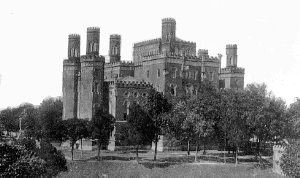
Old State House, Baton Rouge, Louisiana
c. 1880

One of the most prominent political officials of the day was
Zachary Taylor, who in 1848 became the only resident ever elected
president. Taylor, a popular war hero, lead troops in the Mexican War of 1846-1848.
Many troops from Louisiana fought in the Mexican War under General Taylor, and the military
training that many of them, including Lieutenant P. G. T. Beauregard,
used in that war would prove valuable a few years later in the
Civil War.

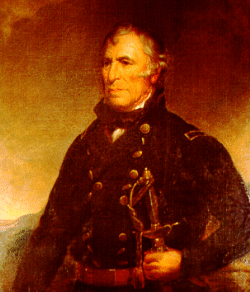
Zachary Taylor
William Garl Brown, Jr.
1847
Gift of Hugh Flynn
This portrait was painted while Taylor was on campaign in Mexico.

Education: Private and Public

In antebellum Louisiana, as in years before, most people received
no formal education at all. Tutors, private academies, and parochial
schools trained the few who could afford an education. Some
parents sent their children, free black as well as white, to the
North or to Europe for schooling.

 Catholic parochial schools remained the most numerous during
the antebellum period as they had during colonial days, but Protestant
schools rose in number, especially in north Louisiana. Catholic parochial schools remained the most numerous during
the antebellum period as they had during colonial days, but Protestant
schools rose in number, especially in north Louisiana.

 New Orleans launched the first public school system in the state
in 1841. From these first schools, public education spread throughout
Louisiana, but very slowly and sporadically.
At the time of the Civil War few parishes in Louisiana had public
schools. New Orleans launched the first public school system in the state
in 1841. From these first schools, public education spread throughout
Louisiana, but very slowly and sporadically.
At the time of the Civil War few parishes in Louisiana had public
schools.

 John McDonogh, a millionaire planter and merchant who had moved from Baltimore to New Orleans prior to the Louisiana Purchase,
gave the New Orleans public school system a major financial boost.
Upon his death in 1850, McDonogh's will left half his estate
to New Orleans and half to Baltimore for the education of white
and free black children. New Orleans established the McDonogh
Fund with its settlement of $704,440, using disbursements from
the fund to build several public schools, called McDonogh Schools,
only one of which was completed before the Civil War. John McDonogh, a millionaire planter and merchant who had moved from Baltimore to New Orleans prior to the Louisiana Purchase,
gave the New Orleans public school system a major financial boost.
Upon his death in 1850, McDonogh's will left half his estate
to New Orleans and half to Baltimore for the education of white
and free black children. New Orleans established the McDonogh
Fund with its settlement of $704,440, using disbursements from
the fund to build several public schools, called McDonogh Schools,
only one of which was completed before the Civil War.

 Authorities excluded all African Americans from Louisiana's
public schools and after 1830 even prohibited free persons from teaching
slaves to read and write. However, the free black community of
New Orleans, which numbered almost 20,000 in 1840, organized its
own schools. The Catholic church also provided education for African
Americans. Carmelite and Ursuline nuns taught free black children
in classes separate from whites. In 1842 church leaders incorporated
the Sisters of the Holy Family, an order of African-American nuns,
who took charge of a parochial school in Faubourg Tremé.
Black philanthropist Thomy Lafon built a home for orphans and
donated it to the sisters in the 1860s. Authorities excluded all African Americans from Louisiana's
public schools and after 1830 even prohibited free persons from teaching
slaves to read and write. However, the free black community of
New Orleans, which numbered almost 20,000 in 1840, organized its
own schools. The Catholic church also provided education for African
Americans. Carmelite and Ursuline nuns taught free black children
in classes separate from whites. In 1842 church leaders incorporated
the Sisters of the Holy Family, an order of African-American nuns,
who took charge of a parochial school in Faubourg Tremé.
Black philanthropist Thomy Lafon built a home for orphans and
donated it to the sisters in the 1860s.

 Many of Louisiana's so-called colleges were little more than
glorified high schools and only admitted men as students. Louisiana's
first institution of higher learning was the College of Orleans,
which operated between 1811 and 1826 in Faubourg Tremé
in New Orleans. Other colleges and academies were incorporated
during the antebellum period, including ones in Opelousas, Convent,
and Jackson. Today, two major Louisiana universities
trace their beginnings to the antebellum period: Tulane University
and Louisiana State University. Many of Louisiana's so-called colleges were little more than
glorified high schools and only admitted men as students. Louisiana's
first institution of higher learning was the College of Orleans,
which operated between 1811 and 1826 in Faubourg Tremé
in New Orleans. Other colleges and academies were incorporated
during the antebellum period, including ones in Opelousas, Convent,
and Jackson. Today, two major Louisiana universities
trace their beginnings to the antebellum period: Tulane University
and Louisiana State University.

 Tulane University began as the Medical College of Louisiana in
1834 and was designated the University of Louisiana in 1845. State
monies were never adequate to operate the school, and in the 1880s
it became the private Tulane University with a large gift from
philanthropist Paul Tulane. Tulane University began as the Medical College of Louisiana in
1834 and was designated the University of Louisiana in 1845. State
monies were never adequate to operate the school, and in the 1880s
it became the private Tulane University with a large gift from
philanthropist Paul Tulane.

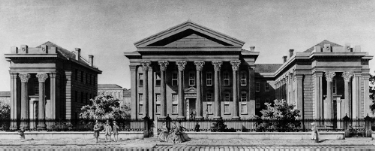
University of Louisiana
B. M. Norman
1848
Courtesy of Tulane University Archives
This school, forerunner of Tulane University, was first located
on University Place in New Orleans, a site now occupied by the
Fairmont Hotel.

Louisiana State University started as the Louisiana State Seminary of Learning and Military
Academy, which opened in 1860 in Pineville. Its first superintendent
was William Tecumseh Sherman, who along with his students abandoned
the school during the Civil War. After fire destroyed the campus
in 1869, authorities relocated the school to Baton Rouge and renamed
it Louisiana State University.

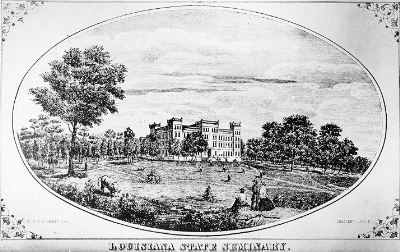
Louisiana State Seminary
Colonel S. H. Lockett
1860
LSU Photograph Collection, RG # A5000, Louisiana State University Archives,
LSU Libraries, Baton Rouge, Louisiana.
The Louisiana State Seminary was originally founded as a military,
agricultural, and mechanical college. The "Fighting Tigers"
of LSU are said to have been named for the tiger mascot of the
Washington Artillery, many of whose members attended the university
after the Civil War.

Like white women in most of the South, Louisiana women rarely
had a formal education, and when they did, it was in institutions
separate from men. The major colleges did not admit women, and
most private and public elementary schools had separate buildings
or floors for male and female students. Female religious orders
educated many of Louisiana's young women, particularly at the
Between Convent in New Orleans and at the several Academies of
the Sacred Heart around the state.

Entertainment: Something for Everyone

The love that colonial Louisiana had for music, dance, and performance
flourished in the antebellum era. Newcomers and travelers to
the state traced this emphasis on amusement to the Latin nature
of south Louisiana, especially New Orleans. Like Europeans, most
Catholic residents of south Louisiana practiced what is known
as the "Continental Sunday," attending Mass on Sunday morning
and socializing in the afternoon and evening.
This custom, like many others common in Louisiana, shocked Protestants
and visitors from the North, especially New England. In the mid-1830s
Henry Didimus New Orleans's Sunday habits
to a northern friend:
It is the Sabbath! A Sabbath in New Orleans! here the noisiest
day of the week--so full of strange contrasts of the grave and gay, saints and
sinners, each engaged in his vocation. It is not the Sabbath of New England.

One of antebellum America's great theater towns, New Orleans
was also the earliest, and for many years the only, city on the
American frontier featuring regular opera productions. Throughout
the antebellum period, residents and visitors to New Orleans could
attend plays in French, English, or German.

 The oldest playhouse in the Crescent City was the St. Peter Street Theater, built originally in 1792 and reconstructed in 1804.
Workers completed the St. Philip Street Theater in 1807, with
a seating capacity of 700. Productions at both theaters were
in French. The first American theater opened in 1823 on Camp
Street, and in 1839 German immigrants built a theater on Magazine
Street to offer German plays. The Théâtre de la
Renaissance, which opened in 1840, had an all-black cast, orchestra
and musical director. The oldest playhouse in the Crescent City was the St. Peter Street Theater, built originally in 1792 and reconstructed in 1804.
Workers completed the St. Philip Street Theater in 1807, with
a seating capacity of 700. Productions at both theaters were
in French. The first American theater opened in 1823 on Camp
Street, and in 1839 German immigrants built a theater on Magazine
Street to offer German plays. The Théâtre de la
Renaissance, which opened in 1840, had an all-black cast, orchestra
and musical director.

 The French Opera House opened in 1859 on the corner of Bourbon and Toulouse Streets in New Orleans, with seating for over 2,000
guests. Laborers and artisans constructed it in less
than six months by working night and day, aided by light from
large fires built in the streets. Before the French Opera House
burned in 1919, it was home to hundreds of public performances
as well as many of the city's lavish Carnival balls. The French Opera House opened in 1859 on the corner of Bourbon and Toulouse Streets in New Orleans, with seating for over 2,000
guests. Laborers and artisans constructed it in less
than six months by working night and day, aided by light from
large fires built in the streets. Before the French Opera House
burned in 1919, it was home to hundreds of public performances
as well as many of the city's lavish Carnival balls.

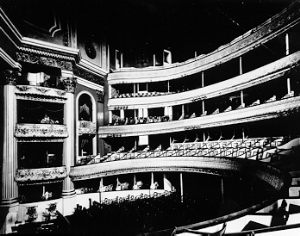
Interior of the French Opera House
Louis T. Fritch
c. 1910
Gift of Louis T. Fritch

In addition to plays and operas, audiences could attend balls,
concerts, and variety acts at the many theaters in New Orleans.
Most places of public entertainment segregated their patrons by
race. Theaters sold less desirable seats to slaves and free blacks,
confining them to balconies or galleries. As in the later part
of the colonial period, ballrooms held dances for whites and free
people of color in separate halls or on different nights of the
week.

 Most famous of all were the "Quadroon Balls," where
white men met young light-skinned women of color. According to
legend, free black mothers placed their daughters with eligible
white bachelors, who agreed to provide them with suitable housing,
clothing, and spending money. Several of these arrangements resulted
in long-term relationships and children. Most famous of all were the "Quadroon Balls," where
white men met young light-skinned women of color. According to
legend, free black mothers placed their daughters with eligible
white bachelors, who agreed to provide them with suitable housing,
clothing, and spending money. Several of these arrangements resulted
in long-term relationships and children.

 Dances, music, and parades also accompanied
the Carnival season in southern Louisiana. This was a carryover from
the colonial era, but in the antebellum period Carnival balls
and parades started taking on their modern forms. Groups of maskers
began using vehicles to parade in 1837. In 1857 nineteen men established
the first formal Carnival organization in New Orleans, the Mistick
Krewe of Comus, which flourished into the 1990s. Dances, music, and parades also accompanied
the Carnival season in southern Louisiana. This was a carryover from
the colonial era, but in the antebellum period Carnival balls
and parades started taking on their modern forms. Groups of maskers
began using vehicles to parade in 1837. In 1857 nineteen men established
the first formal Carnival organization in New Orleans, the Mistick
Krewe of Comus, which flourished into the 1990s.

 Rural slaves gathered on neighboring plantations and farms and
urban slaves met at market sites and other open areas to dance.
In the antebellum period more of Louisiana's slaves were natives
of the United States than of Africa. However, they retained African customs
and fused them with American ones to create new African-American
dance steps, lyrics, music, and instruments. Rural slaves gathered on neighboring plantations and farms and
urban slaves met at market sites and other open areas to dance.
In the antebellum period more of Louisiana's slaves were natives
of the United States than of Africa. However, they retained African customs
and fused them with American ones to create new African-American
dance steps, lyrics, music, and instruments.

 On Sundays, their day off, slaves from New Orleans and the surrounding countryside gathered at large expanses near the
edge of town to exchange goods, news, and dance steps. In 1819,
English-born architect Benjamin Henry Latrobe witnessed one such
Sunday gathering, whare he saw this scene: On Sundays, their day off, slaves from New Orleans and the surrounding countryside gathered at large expanses near the
edge of town to exchange goods, news, and dance steps. In 1819,
English-born architect Benjamin Henry Latrobe witnessed one such
Sunday gathering, whare he saw this scene:
An old man sat astride of a cylindrical drum about a foot in
diameter, & beat it with incredible quickness with the edge of his hand & fingers.
The other drum was an open staved thing held between the knees & beaten in the same
manner. They made an incredible noise. The most curious instrument, however, was
a stringed instrument which no doubt was imported from Africa. On the top of the finger
board was the rude figure of a man in a sitting posture, & two pegs behind him
to which the strings were fastened. The body was a calabash.

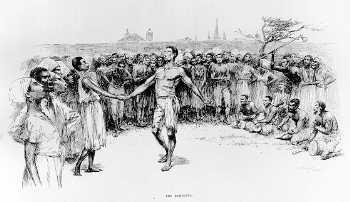
The Bamboula
E. W. Kemble
February 1886
From Century Illustrated Monthly Magazine
The name of this African dance is derived from the large drums,
called bamboulas, used during the performance.

Traveling shows brought plays, concerts, and variety acts to
the smaller towns outside of New Orleans. Although many Protestant
churches in rural northern Louisiana discouraged dancing, Acadians,
or Cajuns, in the south continued to enjoy fais do-dos
(public community dances) and bals de maisons (private dancing
parties) as they had during colonial times.

 New Orleans native Louis Moreau Gottschalk was the first
musician from the United States to win worldwide praise and recognition
for his compositions, many of which were based on Creole, African-American,
and other native Louisiana melodies. Gottschalk's father was Jewish immigrant from England, and his mother was the daughter of Saint-Domingue refugees. One of his
most famous pieces is Bamboula, a composition influenced by songs he learned as a child from his maternal grandmother and his African-American nurse, both Saint-Domingue refugess. New Orleans native Louis Moreau Gottschalk was the first
musician from the United States to win worldwide praise and recognition
for his compositions, many of which were based on Creole, African-American,
and other native Louisiana melodies. Gottschalk's father was Jewish immigrant from England, and his mother was the daughter of Saint-Domingue refugees. One of his
most famous pieces is Bamboula, a composition influenced by songs he learned as a child from his maternal grandmother and his African-American nurse, both Saint-Domingue refugess.


Berceuse
Louis Moreau Gottschalk
1862
Gift of Mrs. Anthony Guarino
This sheet music bears the likeness of Gottschalk.

Edmond Dédé, the son of two free blacks
from the West Indies, was also one of New Orleans's leading musicians.
Born in New Orleans in 1829, Dédé studied the violin
there and later in Mexico, England, and France. He conducted
the classical orchestra of L'Acazar in Bordeaux, France, and wrote
more than forty compositions before his death in 1903.

 Jenny Lind, the world-renowned Swedish Nightingale, was
among the many touring attractions who performed in Louisiana.
Accompanying Lind on her grand American tour was her manager,
P. T. Barnum of circus fame. People from all over the Mississippi
Valley converged upon New Orleans to hear Lind sing. During her
stay, Lind was the houseguest of the Baroness de Pontalba in a
townhouse specially furnished for the singer. After Lind left
New Orleans, the Baroness auctioned off the furniture and personal
items left in the townhouse to Lind's many adoring fans.
Jenny Lind, the world-renowned Swedish Nightingale, was
among the many touring attractions who performed in Louisiana.
Accompanying Lind on her grand American tour was her manager,
P. T. Barnum of circus fame. People from all over the Mississippi
Valley converged upon New Orleans to hear Lind sing. During her
stay, Lind was the houseguest of the Baroness de Pontalba in a
townhouse specially furnished for the singer. After Lind left
New Orleans, the Baroness auctioned off the furniture and personal
items left in the townhouse to Lind's many adoring fans.
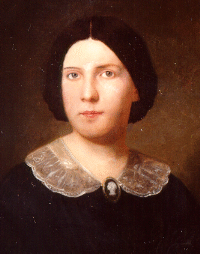
Jenny Lind
c. 1850

Louisiana native Adah Isaacs Menken earned acclaim as
an actress on both sides of the Atlantic. A child prodigy who
spoke several languages, wrote poetry, and sculpted, Menken made
her acting debut in Shreveport, Louisiana, in 1857 at the age
of twenty-two. She performed in most major United States cities and in London
and Paris. During her short lifetime of thirty-three years, Menken's four
marriages and divorces gained her as much notoriety as her acting
did.

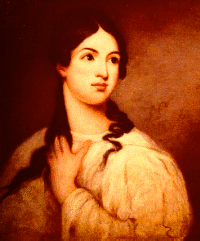
Adah Isaacs Menken
William Henry Baker
c. 1860

 Antebellum Louisiana II - Immigration Antebellum Louisiana II - Immigration

Introduction | Native Americans | Colonial Louisiana | Louisiana Purchase | Territory to Statehood
Battle of New Orleans | Antebellum LA. - Politics | Antebellum LA. - Immigration
Antebellum LA. - Death & Mourning | Antebellum LA. - Agrarian Life | Antebellum LA. - Urban Life
Civil War |
Reconstruction - A State Divided | Reconstruction - Change and Continuity
LSM Home Page
|










